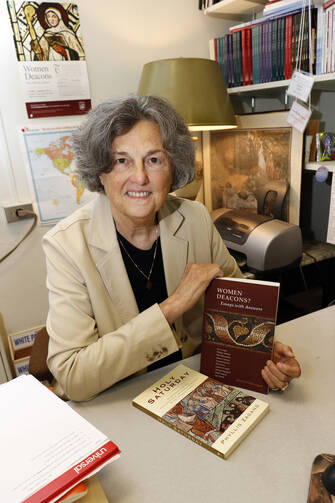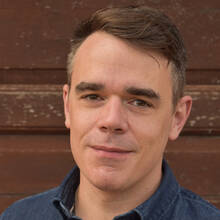One of the two Americans picked by Pope Francis to serve on a new commission studying the history of women serving as deacons in the Catholic Church said she is “honored” by the appointment and called the commission’s work “high stakes.”
Phyllis Zagano, who teaches religion at Hofstra University and who has written extensively about women deacons in the early church, told America she believes there are three questions to consider—two for the commission and one for Pope Francis.
“Were women ordained as deacons? I believe yes. Can women be ordained as deacons? I believe yes,” she said.
“Should women be ordained as deacons? This is a question for the Holy Father to discern on behalf of the whole church.”
Zagano is one of 12 people, including six women and six men, appointed to the commission, the Vatican announced Tuesday.
RELATED: Vatican Announces Commission on Women Deacons
If the church someday comes to the decision to ordain women deacons, Zagano said, she envisions it playing out differently across the globe.
It would be up to “individual bishops,” she said, “to decide first if he needs deacons and second if he needs women deacons.”
Zagano said local needs and customs would have to inform any decision about women deacons.
“I don’t think that as an American I can speak for all cultures,” she said.
“I can speak to the historical veracity of the women diaconate,” she continued. “But for me to tell the bishop of country x, y or z...he must have women deacons, I don’t think that’s my place.”
Zagano laid out her case for women deacons in a 2003 essay in America, in which she argued, “Women are now called and have been called in the past to the diaconate.”
“The ordained ministry of service by women is necessary to the church—that is, to both the people of God and the hierarchy,” she wrote. “As a result, the ordination of women to the diaconate is possible.”
RELATED: Catholic Women Deacons by Phyllis Zagano
Reacting to the pope’s announcement Tuesday, Chicago’s Archbishop Blase Cupich said in a statement that he welcomed the news, and he made a call for the church to place women in leadership roles.
“From the earliest days of the church, women rightly served in key leadership roles,” said Cupich, who was picked last month by the pope to serve on a committee that helps pick new bishops. “Still, the church must do better. Women deserve to be brought more fully into the decision-making of the church.”
A group advocating for women priests also praised the news.
“The commission to study the diaconate for women is an important step for the Vatican in recognizing its own history of honoring women's leadership,” the Women’s Ordination Conference said in a statement. “Biblical and historical evidence cites several women leaders working alongside men in the early church.”
Back in May, Pope Francis announced that he supported the idea of establishing a commission to investigate if women had ever served as ordained deacons or merely as assistants in the early church.
But the pope later said he was “angry” at media reports that suggested he was opening the diaconate to women, rather than offering support to study a particular historical question.
“They said, ‘The church opens the door to deaconesses.’ Really?” he said in a June 26 press conference. “I am a bit angry because this is not telling the truth of things.”
Catholic scholars of varying stripes tend to agree that women did serve in some sort of deacon-like role in the early church. The controversial question, however, is whether women leaders were ordained or if they assisted ordained priests and deacons.
Those who support the notion of women deacons frame the argument as readmitting women to the diaconate rather than expanding the ministry to include women. On the other side, those opposed say that deacons today are understood to be part of the church’s ordained ministry—a role that is thus closed to women.
Deacons had been part of the early church’s leadership structure for centuries, but the role had largely faded away sometime around the fifth century. Men studying to be priests were still ordained as deacons during the following years but only provisionally on their pathway to the priesthood.
Following Vatican II, however, the church restored the ministry of permanent deacons. There are about 15,000 active in the United States today.
This won’t be the first time the Vatican has studied the possibility of women deacons in recent decades.
In 2002, the International Theological Commission wrapped up a decade long study that included the question of women deacons. Father Georges Cottier, the head of that commission, said at the time that while the group came to no definitive position, it generally felt women had not served in a sacramental role in the early church. But the commission hedged on whether or not women could be part of the modern diaconate.
The decision, he said, “belongs to the magisterium to pronounce with authority on the question.”







